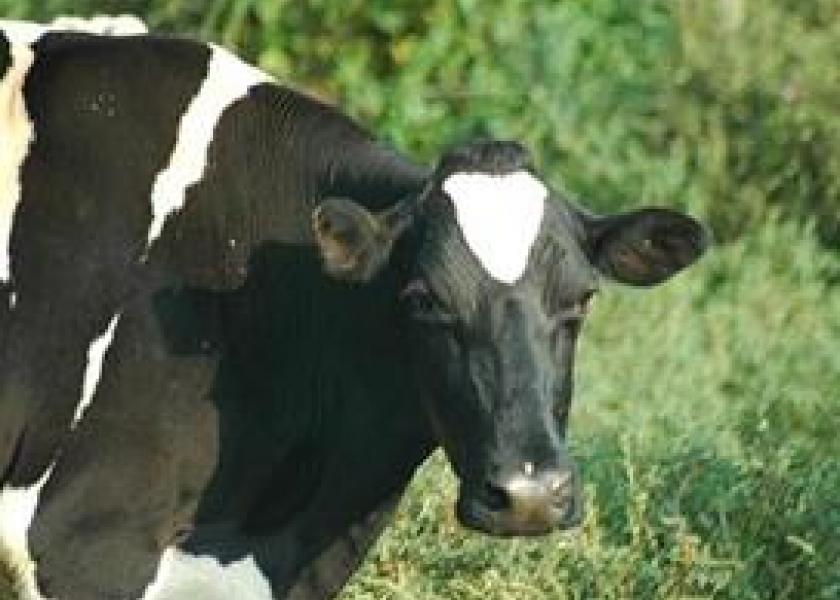Moms Favor Daughters in Dairy Study

By: Mary Lou Peter, K-State Research & Extension News
Sorry, boys. In the end, mothers favor daughters – at least when it comes to Holstein dairy cows and how much milk they produce for their offspring, according to a new study by Kansas State University and Harvard University researchers.
A study of 2.39 million lactation records from 1.49 million dairy cows showed that cows produce significantly more milk for daughters than for sons across lactation, said Barry Bradford, associate professor in K-State’s Department of Animal Sciences and Industry. He, along with Katie Hinde in Harvard’s Department of Human Evolutionary Biology, Abigail Carpenter, K-State graduate student and John Clay, with Dairy Records Management Systems collaborated on the study.
"Our results provide the first direct evidence that the sex of a gestating fetus can influence milk production," Bradford said. "One possible explanation is that a daughter is able to let her mom know, in advance, that she expects to receive more milk than her brothers."
In addition, the researchers found that the sex of the fetus a cow is carrying can enhance or diminish the production of milk during an established lactation and that the sex of the fetus gestated in the first pregnancy has persistent consequences for milk production on the second lactation.
The study could have implications for humans, Hinde said.
Results of the study are available in the scientific journal, PLOS One.
"Among the surprises in this study was the fact that the bias was in favor of daughters rather than sons, as some evolutionary hypotheses have predicted. Daughters seemed to have the most dramatic effect on the initial development of the mammary gland, because the bias against sons was greatest in the first lactation," Bradford said.
The team also found that the percent fat and protein in milk did not differ between cows that gestated a son or daughter, so the quality of milk was the same. However, because the quantity was greater after gestating a daughter, the total amount of milk fat and protein after gestating a daughter were higher than after gestating a son.
Standardized husbandry in the dairy industry, combined with systematic milking procedures, detailed record-keeping, and large sample sizes made the dairy cow a powerful model for the exploration of milk synthesis.
The study was derived from all lactation records from 1995 to 1999 in a database managed by Dairy Records Management Systems of Raleigh, N.C.
How does the fetus influence milk synthesis? It’s likely that hormones from the fetus and placenta differ between fetal sons and daughters. Those hormones may subsequently enter the maternal bloodstream and affect milk-producing cells in the mammary gland, the researchers said in a Jan. 22 statement.
"After finding the programming effect of fetal sex on subsequent lactations, our team discussed the possibility that daughters were releasing hormones into the maternal circulation that could directly influence the mammary gland," Bradford said. "It occurred to us that if this was true, becoming pregnant with a daughter might influence milk production even in an ongoing lactation. I was floored when we tested that effect and found it to be significant as well."
Cows with two daughters back-to-back produced about 445 kilograms – or about 980 pounds – more milk across the first two lactations than did cows with back-to-back sons, he said.
Artificial insemination is standard practice in the dairy industry and sex-selected semen is an option for producers to buy.
"According to our rough calculations, taking into account the wholesale value of milk, the number of two-year-old heifers added to U.S. dairy herds annually, the production advantage across the first two lactations of conceiving a daughter on the first pregnancy, and the increased probability of conceiving a daughter from sex-selected semen, suggests a gross value in the neighborhood of $200 million in milk production across the first two lactations alone," the team reported.
Implications for humans
"Well no study has yet systematically addressed differences in milk for sons and daughters in terms of both composition and yield," said Hinde. "But in the last couple years there have been a handful of studies among humans reporting differences in milk composition between sons and daughters. Humans have a very invasive placenta that would allow fetal hormones to pass into maternal circulation and possibly influence mammary gland development. But it hasn’t yet been systematically studied."
"This research in cows demonstrates that the fetus can influence the milk the mother produces during lactation and limited evidence suggests that similar processes may be operating in humans," she added. "Such a finding has potential implications for nutrition management of babies in neonatal intensive care units and selection of donor milks. And such research can inform infant formulas tailored more specifically to the physiological needs of sons and daughters."







